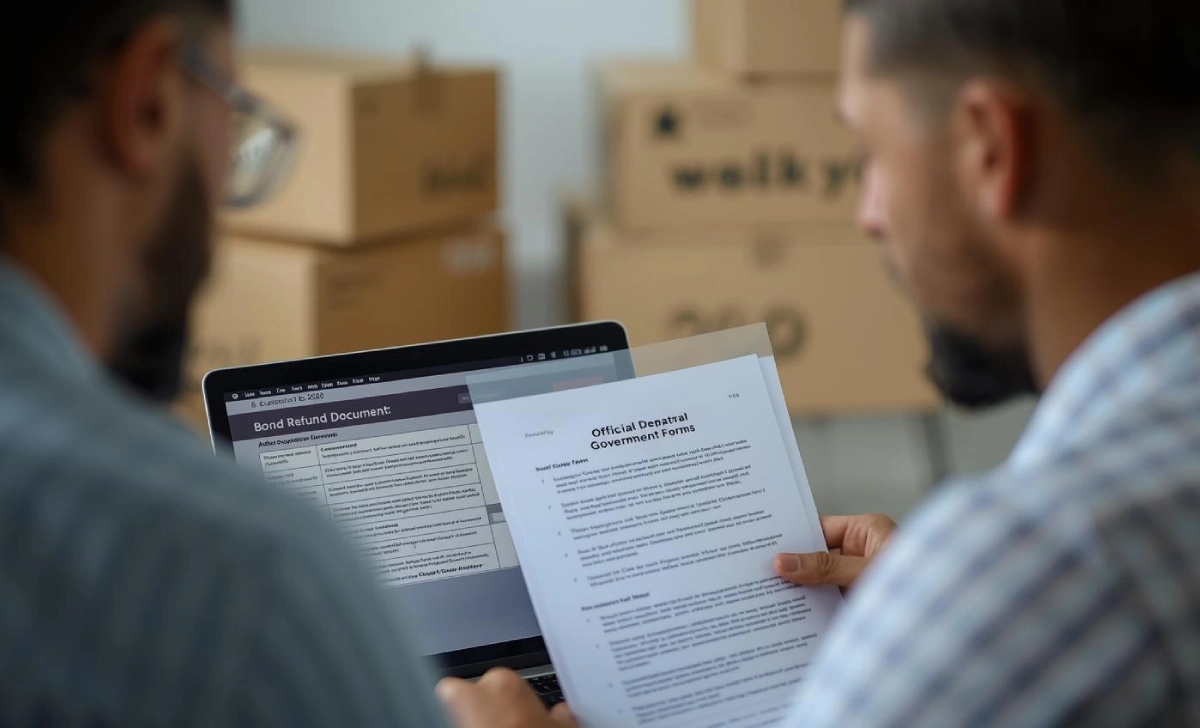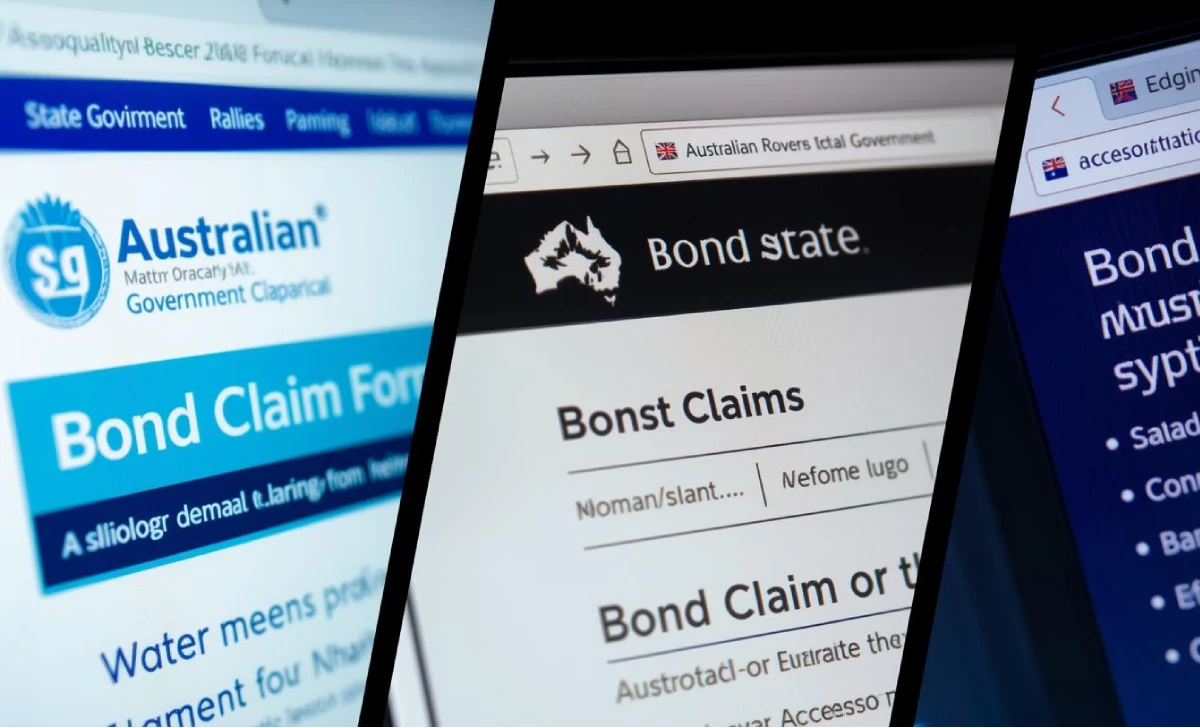Worried you won’t get your bond back when your lease ends? This guide walks you through the step-by-step process to get your bond back in Australia, state-by-state, with evidence checklists and two editable letter templates you can copy and paste.
- How Bond Handling Works in Australia
- State-by-State Step-by-Step Process (NSW, VIC, QLD, WA, SA, TAS, ACT, NT)
- Before You Move Out — Evidence Checklist and Condition Report Best Practice
- Repairs, Cleaning and Ordinary Wear & Tear — What Landlords Can Legally Deduct
- How to Lodge a Bond Claim & What to Expect (Forms, Signatures, Timelines)
- Two Editable Letter Templates + How to Use Them
- If the Landlord Disputes Deductions — Tribunal & Escalation Path
- FAQs
- Conclusion
With rental bonds often worth 4-6 weeks’ rent — that’s $2,000-$3,000 in major cities — protecting your refund is crucial for your finances. Unfortunately, bond disputes are increasingly common, with NSW Fair Trading reporting over 15,000 bond claims requiring tribunal intervention in 2024.
Whether you’re ending your first lease or you’ve had bond issues before, this practical guide covers everything from state-specific claim procedures to defending against unfair deductions. You’ll know exactly what evidence to collect, which forms to complete, and how to handle disputes professionally.

How Bond Handling Works in Australia
Rental bonds in Australia are security deposits held against potential property damage, unpaid rent, or excessive cleaning costs. While the core principles are consistent nationwide, each state has its own authority that manages bond procedures and dispute resolution.
Bond basics at a glance:
• Purpose — Security for landlords against damage beyond normal wear and tear
• Amount — Typically 4 weeks’ rent (some states allow up to 6 weeks)
• Holding — Must be lodged with state authority within specified timeframes
• Refund timeframes — Usually 7-21 days if both parties agree to release
Most bonds are refunded in full when tenancies end without major issues. However, common deduction disputes arise over cleaning standards, minor damage claims, and misunderstandings of “normal wear and tear” rules.
The key to getting your bond back in Australia successfully is understanding your state’s specific procedures and maintaining proper documentation throughout your tenancy. Each jurisdiction has different online systems, forms, and tribunal processes.
State-by-State Step-by-Step Process (NSW, VIC, QLD, WA, SA, TAS, ACT, NT)
Each Australian state and territory has its own bond authority and claim procedures. Here’s exactly what you need to do in your jurisdiction:
| State/Territory | Bond Authority | Claim Process | Typical Timeframe |
|---|---|---|---|
| NSW | Rental Bonds Online (Service NSW) | Online claim form through Service NSW portal | 14 days if agreed, 21+ days if disputed |
| VIC | Consumer Affairs Victoria | Bond Authority online or paper forms | 10 business days if agreed |
| QLD | Residential Tenancies Authority (RTA) | RTA Web Services or Form 4 | 14 days if agreed |
| WA | Bond Administrator (DMIRS) | Online through Bond Administrator portal | 14 days if agreed |
| SA | Consumer and Business Services | Residential Bonds Board forms | 7 days if agreed |
| TAS | Residential Tenancy Commissioner | Monetary Deposits Board application | 10 business days if agreed |
| ACT | Access Canberra | Rental Bonds Board online or paper | 14 days if agreed |
| NT | Consumer Affairs NT | Bond claim forms through NT Gov | 14 days if agreed |
NSW Process: Log into Service NSW, complete the bond refund claim, upload condition reports and photos. If landlord disputes, you’ll need to apply to NCAT within 30 days.
Victoria Process: Submit Form 7 (Bond Claim) through Consumer Affairs Victoria website. Include detailed reasons for full refund and attach supporting evidence. Disputes go to VCAT.
Queensland Process: Use RTA Web Services to submit claim or complete Form 4. Take photos of property condition before leaving. Disputes are handled by QCAT.
Western Australia Process: Access Bond Administrator portal, complete refund application with property photos and cleaning receipts. SAT handles disputes.
Each state requires similar documentation: final condition report, photos showing property state, cleaning receipts (if required by lease), and correspondence with landlord about any issues.

Before You Move Out — Evidence Checklist and Condition Report Best Practice
The best defence for your bond starts on day one of your tenancy. Proper documentation throughout your lease makes the refund process straightforward and protects against unfair claims.
Move-in documentation:
- Complete condition report thoroughly — Don’t sign until every mark, stain, and defect is recorded
- Take time-stamped photos — Every room from multiple angles, close-ups of existing damage
- Upload to cloud storage — Ensures photos have verifiable timestamps and won’t be lost
- Email landlord/agent — Send condition report photos within 48 hours for their records
Pre-move-out checklist:
□ Review original condition report and photos
□ Complete thorough cleaning (or book professional service if required)
□ Repair any damage beyond normal wear and tear
□ Take “after” photos matching original angles
□ Keep all cleaning and repair receipts
□ Complete final condition report with landlord/agent
Example success story: Sarah from Melbourne took 15 photos of each room when moving in, noting carpet stains and wall marks on the condition report. When moving out 18 months later, she referenced these original photos to successfully argue that “new” carpet stains were pre-existing, securing a full $2,400 bond refund.
Photo checklist best practice:
• Use consistent file naming: “Bedroom1_MoveIn_Date” and “Bedroom1_MoveOut_Date”
• Capture wide shots and close-ups of any defects
• Include timestamps in photo metadata
• Take photos in good lighting conditions
• Document appliance conditions and cleanliness standards
Repairs, Cleaning and Ordinary Wear & Tear — What Landlords Can Legally Deduct
Understanding the difference between “ordinary wear and tear” versus “damage” is crucial for protecting your bond. Australian tenancy laws protect tenants from paying for normal deterioration that occurs through reasonable use.
| Landlord May Deduct | Landlord Should NOT Deduct |
|---|---|
| Broken windows or fixtures | Faded paint or wallpaper |
| Carpet burns or large stains | Normal carpet wear patterns |
| Holes in the walls from nails/screws | Minor scuff marks on the walls |
| Missing or broken items | Light switch discolouration |
| Damage from pets | Worn door handles/locks |
| Excessive dirt requiring professional cleaning | General dust and grime |
Cleaning obligations: Most leases require you to return the property in the same condition as when you moved in, allowing for fair wear and tear. This typically means:
• General cleaning — Standard domestic cleaning of all surfaces
• Professional cleaning — Only if specifically required in your lease agreement
• Carpet cleaning — Professional cleaning only if the lease specifies or carpets are excessively soiled
• Window cleaning — Internal windows unless the lease states otherwise
Defending against unfair deductions: If your landlord claims excessive cleaning costs, request itemised invoices and compare quotes. In NSW, the average professional cleaning costs $300-500 for a two-bedroom unit, while carpet cleaning ranges from $150-300 per room.
Keep receipts for any cleaning services you arrange. This demonstrates a good faith effort and provides evidence if landlords attempt to claim higher costs for the same work.
How to Lodge a Bond Claim & What to Expect (Forms, Signatures, Timelines)
The bond claim process varies by state, but the general procedure follows similar steps across Australia. Understanding these timelines helps you plan your move and follow up appropriately.
Standard bond claim timeline:
- Days 0-7: Submit the bond claim form through your state authority’s online portal or by post. Include all required documentation: condition reports, photos, cleaning receipts, and forwarding address.
- Days 7-14: Authority contacts landlord for agreement or dispute notification. If the landlord agrees, refund is processed automatically. Most straightforward claims are resolved within this period.
- Days 14-21:If the landlord disputes the claim, you’ll receive notification and instructions for the tribunal application. This is when your documentation becomes crucial for defending your position.
- Days 21+: Tribunal hearing scheduled if the dispute cannot be resolved through mediation. Typical resolution time is 4-8 weeks from application.
What happens if the landlord is unresponsive?
In most states, if the landlord fails to respond to the bond authority within the specified timeframe (usually 14 days), the full bond is automatically released to the tenant. This protects tenants from landlords who simply ignore the process.
Online vs paper applications:
Most states now offer online bond claim systems that are faster and provide automatic updates. Paper applications typically take 2-3 days longer to process initially but follow the same dispute resolution procedures.
Two Editable Letter Templates + How to Use Them
Use these professional templates to communicate effectively with landlords and prepare tribunal applications. Both templates are designed to be direct, factual, and legally appropriate.
Template A: Final Inspection & Bond Release Request
Subject: Bond Release Request - [Property Address]
Dear [Landlord/Property Manager Name],
I am writing to request the release of my rental bond for [Property Address], as I will be vacating on [Date].
The property has been maintained in excellent condition throughout the tenancy and returned to the same standard as documented in the initial condition report dated [Date]. I have:
• Completed thorough cleaning of all areas
• Arranged professional carpet cleaning [if required by lease]
• Repaired any damage beyond normal wear and tear
• Taken final condition photos for comparison with move-in documentation
Please arrange the final inspection at your earliest convenience. My forwarding address for bond correspondence is:
[New Address]
I expect the full bond amount of $[Amount] to be released through [State Bond Authority] following our inspection.
Thank you for your prompt attention to this matter.
Regards,
[Your Name]
[Date]
[Contact Number]
Template B: Tribunal Application Statement
BOND DISPUTE - TRIBUNAL APPLICATION
Applicant: [Your Name]
Property: [Address]
Bond Amount: $[Amount]
Landlord/Agent: [Name]
STATEMENT OF FACTS:
1. Tenancy commenced [Date] with bond of $[Amount] lodged with [State Authority]
2. Tenancy ended [Date] with property returned in excellent condition
3. Landlord has incorrectly claimed deductions of $[Amount] for [specific claims]
4. These deductions are unjustified because [specific reasons with reference to condition report]
EVIDENCE PROVIDED:
• Original condition report dated [Date]
• Move-in photographs (Exhibits A1-A20)
• Move-out photographs (Exhibits B1-B20)
• Cleaning receipts dated [Date]
• Correspondence with landlord (Exhibits C1-C5)
REMEDY SOUGHT:
Full bond refund of $[Amount] plus tribunal filing fee of $[Amount if applicable]
[Your Signature]
[Date]
Customisation tips:
• Replace all bracketed placeholders with your specific details
• Attach numbered exhibits referenced in your statement
• Keep tone professional and factual, not emotional
• File within your state’s specified timeframe (usually 28-30 days)
If the Landlord Disputes Deductions — Tribunal & Escalation Path
When landlords dispute your bond claim, the matter escalates to your state’s civil and administrative tribunal. Being prepared with proper evidence and understanding the process significantly improves your chances of success.
Tribunal preparation checklist:
□ Compile all photographic evidence in chronological order
□ Print condition reports with clear before/after comparisons
□ Gather cleaning and repair receipts
□ Prepare witness statements if relevant (previous tenants, tradespeople)
□ Calculate claimed deductions versus actual reasonable costs
□ Draft a clear timeline of tenancy events
What to expect at the hearing: Tribunal hearings are informal but structured. You’ll present your case first, followed by the landlord. The member will ask questions and examine evidence before making a decision, usually on the day.
Presenting your case effectively: “Your Honour, I’m seeking a full bond refund of $2,000. The landlord claims $800 for carpet cleaning and $400 for wall damage. However, my evidence shows the carpet stains were documented at move-in [reference photos A1-A3] and the wall marks are normal wear and tear after 24 months [reference photos B1-B2].”
Typical outcomes:
• Full refund — When the tenant provides clear evidence that clearly shows no damage or excessive wear
• Partial refund — When some legitimate costs are proven, but others are disputed
• No refund — Rare, usually only when significant unreported damage occurred
Most tribunals favour tenants who can demonstrate they documented the property condition properly and made reasonable efforts to maintain it.
FAQs
Q: How long before I get my bond back?
Usually 7-14 days if the landlord agrees to full release. If disputed, allow 4-8 weeks for tribunal resolution.
Q: Can the landlord keep bond for cleaning?
Only if the lease specifically requires professional cleaning or the property is excessively dirty beyond normal use.
Q: What if the landlord won’t sign the release form?
Apply to your state tribunal within 28-30 days. In some states, non-response means automatic release.
Q: Do I need to use a professional cleaner?
Only if your lease agreement specifically requires it. Standard domestic cleaning is usually sufficient.
Q: Can I get interest on my bond?
Some states (like NSW) pay interest on bonds. Check with your state authority for current rates.
Q: What if I damaged something accidentally?
Be honest about legitimate damage and get repair quotes. Minor accidental damage is often negotiable.
Conclusion
Getting your bond back in Australia successfully comes down to preparation and documentation. Complete thorough condition reports, maintain photographic evidence throughout your tenancy, and use the letter templates provided to communicate professionally with landlords.
Remember that most bonds are refunded without dispute when tenants can demonstrate they’ve maintained the property appropriately. If disagreements arise, state tribunals provide accessible dispute resolution, typically favouring tenants with proper evidence.
Start documenting your property condition today, download the templates above, and bookmark your state’s bond authority website. With the right preparation, you can confidently get your bond back in Australia and protect your rental deposit investment.






